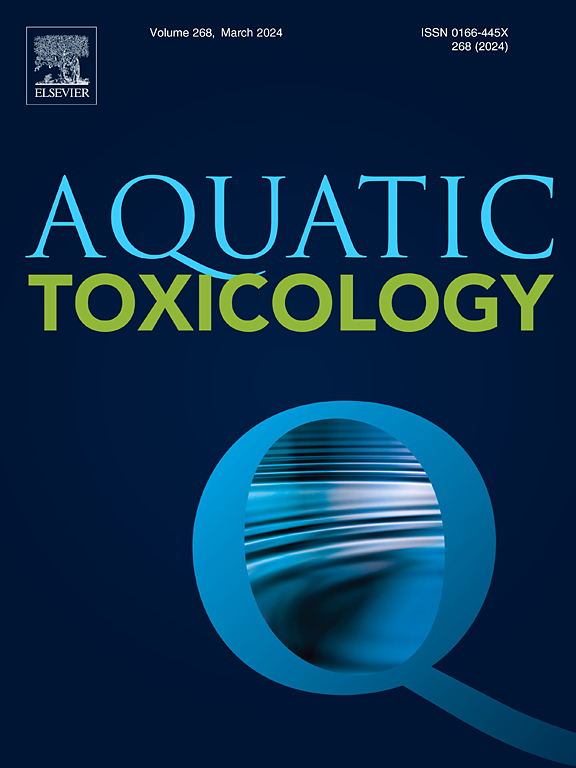2-羟基蒽醌通过铁下垂诱导斑马鱼心脏毒性
IF 4.3
2区 环境科学与生态学
Q1 MARINE & FRESHWATER BIOLOGY
引用次数: 0
摘要
2-羟基蒽醌(2-hATQ)是一种多环芳烃——蒽(ANT)的光化学氧化产物。ANT因其耐降解和在环境中的持久性而被美国环境保护署(EPA)列为优先污染物。由于ANT的特性,2-hATQ也可以在环境中无处不在,并且比其母体化合物ANT毒性更大,对环境安全和人类健康构成重大风险。然而,关于其毒理学效应,特别是心血管毒性的研究有限。在本研究中,斑马鱼胚胎急性暴露于不同浓度的2-hATQ(0、0.4、0.8和1.2 mg/L)下,表现出明显的心脏发育异常,表现为心率减慢、心包水肿和心脏畸形。转录组测序分析和定量实时聚合酶链反应(qPCR)研究表明,2-hATQ通过破坏抗氧化系统、谷胱甘肽消耗、增加多不饱和脂肪和铁离子积累等途径诱导心肌铁凋亡。与铁下垂抑制剂(fer1)共同暴露可有效挽救心脏形态异常。成年斑马鱼暴露于低浓度2-hATQ环境28天后,心室形态减少,内部结构出现部分空泡化和纤维化。本研究首次揭示了2-hATQ暴露对水生生物心脏发育的负面影响,这一发现可能为深入了解2-hATQ及其他与ant相关的环境风险物质提供重要的见解和参考。本文章由计算机程序翻译,如有差异,请以英文原文为准。

2-Hydroxyanthraquinone induces cardiotoxicity in zebrafish via ferroptosis
2-Hydroxyanthraquinone (2-hATQ) is a photochemical oxidation product of anthracene (ANT), a polycyclic aromatic hydrocarbon. ANT is listed as a priority pollutant by the US Environmental Protection Agency (EPA) due to its resistance to degradation and persistence in the environment. Because of ANT's characteristics, 2-hATQ can also be ubiquitously present in the environment and is more toxic than its parent compound ANT, posing significant risks to environmental safety and human health. Nevertheless, there are limited studies addressing its toxicological effects, particularly concerning cardiovascular toxicity. In the present study, zebrafish embryos acutely exposed to 2-hATQ (0, 0.4, 0.8, and 1.2 mg/L) at different concentrations showed significant cardiac developmental abnormalities, as evidenced by slowing of the heart rate, pericardial edema, and the cardiac malformations. Transcriptomic sequencing analysis and quantitative real-time polymerase chain reaction (qPCR) study showed that 2-hATQ induced cardiac ferroptosis via disruption of the antioxidant system, glutathione depletion, increase in polyunsaturated fats and accumulation of iron ions. Co-exposure of ferroptosis inhibitor (Fer-1) effectively rescues the morphological abnormalities of the heart. After exposing adult zebrafish to low concentration 2-hATQ for 28 days, ventricular morphology was reduced and internal structures showed partial vacuolation and fibrosis. This study reveals for the first time the negative influence of 2-hATQ exposure on the cardiac development of aquatic organisms and this discovery may offer significant insights and references for an in-depth understanding of 2-hATQ and other ANT-related environmental risk substances.
求助全文
通过发布文献求助,成功后即可免费获取论文全文。
去求助
来源期刊

Aquatic Toxicology
环境科学-毒理学
CiteScore
7.10
自引率
4.40%
发文量
250
审稿时长
56 days
期刊介绍:
Aquatic Toxicology publishes significant contributions that increase the understanding of the impact of harmful substances (including natural and synthetic chemicals) on aquatic organisms and ecosystems.
Aquatic Toxicology considers both laboratory and field studies with a focus on marine/ freshwater environments. We strive to attract high quality original scientific papers, critical reviews and expert opinion papers in the following areas: Effects of harmful substances on molecular, cellular, sub-organismal, organismal, population, community, and ecosystem level; Toxic Mechanisms; Genetic disturbances, transgenerational effects, behavioral and adaptive responses; Impacts of harmful substances on structure, function of and services provided by aquatic ecosystems; Mixture toxicity assessment; Statistical approaches to predict exposure to and hazards of contaminants
The journal also considers manuscripts in other areas, such as the development of innovative concepts, approaches, and methodologies, which promote the wider application of toxicological datasets to the protection of aquatic environments and inform ecological risk assessments and decision making by relevant authorities.
 求助内容:
求助内容: 应助结果提醒方式:
应助结果提醒方式:


